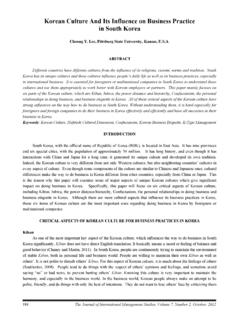Transcription of Understanding Economic Statistics: An OECD Perspective
1 Und er s t anding Und er s t anding Economic statistics . Economic statistics . AN OECD Perspective . Governments make decisions, affecting everybody, based on the Economic statistics Under st anding Economic . available to them. The media publish Economic data on a daily basis. In countless different ways, Economic statistics are a fundamental part of modern life, shaping the way we interpret statistics . and react to the world around us. But how are these statistics produced? Who decides which statistics are useful and which are not?
2 And how can we be sure of the quality of the statistics we read? Drawing on OECD statistics in particular, Understanding Economic statistics : An OECD. Perspective shows readers how to use statistics AN OECD Perspective . to understand the world economy. It gives an overview of the history, key concepts as well as information about the main providers of Economic statistics . A detailed chapter provides a comprehensive picture of the main statistical activities of the OECD. Finally, the book explores Enrico Giovannini the crucial issue of quality assurance and the implications for public trust.
3 This book is an essential reference for anybody interested in better Understanding the important role that Economic statistics play in our lives. isbn 978-92-64-03312-2. 30 2008 27 1 P. XXX PFDE PSH QVCMJTIJOH. -:HSTCQE=UXXVWW: Understanding Economic statistics AN OECD Perspective . Enrico Giovannini ORGANISATION FOR Economic CO-OPERATION. AND DEVELOPMENT. The OECD is a unique forum where the governments of 30 democracies work together to address the Economic , social and environmental challenges of globalisation.
4 The OECD is also at the forefront of efforts to understand and to help governments respond to new developments and concerns, such as corporate governance, the information economy and the challenges of an ageing population. The Organisation provides a setting where governments can compare policy experiences, seek answers to common problems, identify good practice and work to co-ordinate domestic and international policies. The OECD member countries are: Australia, Austria, Belgium, Canada, the Czech Republic, Denmark, Finland, France, Germany, Greece, Hungary, Iceland, Ireland, Italy, Japan, Korea, Luxembourg, Mexico, the Netherlands, New Zealand, Norway, Poland, Portugal, the Slovak Republic, Spain, Sweden, Switzerland, Turkey, the United Kingdom and the United States.
5 The Commission of the European Communities takes part in the work of the OECD. OECD Publishing disseminates widely the results of the Organisation's statistics gathering and research on Economic , social and environmental issues, as well as the conventions, guidelines and standards agreed by its members. This work is published on the responsibility of the Secretary-General of the OECD. The opinions expressed and arguments employed herein do not necessarily reflect the official views of the Organisation or of the governments of its member countries.
6 Chapters 1, 2, 3 and 5 of this book are translated and adapted from Le statistiche economiche by Enrico Giovannini, Bologna, Societ editrice il Mulino, 2006. Copyright 2006 by Societ editrice il Mulino, Bologna. Corrigenda to OECD publications may be found on line at: OECD 2008. You can copy, download or print OECD content for your own use, and you can include excerpts from OECD publications, databases and multimedia products in your own documents, presentations, blogs, websites and teaching materials, provided that suitable acknowledgment of OECD as source and copyright owner is given.
7 All requests for public or commercial use and translation rights should be submitted to Requests for permission to photocopy portions of this material for public or commercial use shall be addressed directly to the Copyright Clearance Center (CCC) at or the Centre fran ais d'exploitation du droit de copie (CFC) Foreword Foreword The aim of this book is to help the reader to better understand how to use Economic statistics in general and OECD statistics in particular. It introduces the main concepts used by statisticians and economists to measure Economic phenomena and provides tables and charts with relevant data.
8 Moreover, the book describes how the production of international statistics is organised, who are the main data producers, what are the main databases available over the Internet and how can the quality of statistics be assessed. Thanks to this book, the users will better understand where to find and how to use OECD statistics on gross domestic product, government's public deficit and debt, short-term Economic indicators, different sectors of Economic activity, globalisation, innovation, labour market, etc.
9 Special attention is paid to indicators used to assess both macroeconomic and structural policies. In each section, references to sources and suggestions for further reading are provided. Why this book? As Jean-Claude Trichet, President of the European Central Bank, said at the 2004 OECD Forum on statistics , Knowledge and Policy , nowadays we are bombarded by statistics , the volume of which often creates confusion, rather than information. The challenge to find the most appropriate figures for a particular phenomenon becomes even harder when international comparisons are needed.
10 The number of sources increased dramatically over the last decade and the use of search engines on Internet sometimes help in finding the best source, but often they list websites that contain conflicting data or do not provide appropriate metadata to assess their quality. The OECD is recognised worldwide as a formidable source of statistical information on Economic , social and environmental topics and this book aims to help students and researchers better understand the world in which they live and find appropriate evidence to carry out their work.











